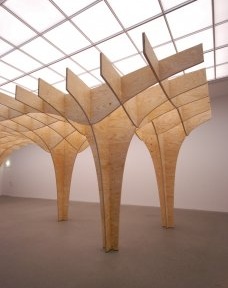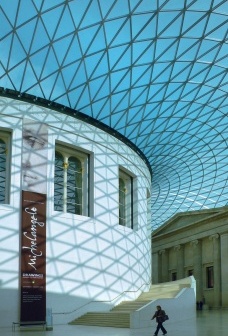
newspaper
agenda cultural
Exhibition about the effect and significance of the classic work by Konrad Wachsmann
In 1959, the architect Konrad Wachsmann (1901–1980), who designed Albert Einstein’s house in Caputh, published his book ‘Turning Point of Building’ that became a manifest of that age for the consistent industrialisation of architecture. 50 years on, the Museum of Architecture at the Technische Universität München, together with the departments of structural planning and architectural engineering, are investigating the effect and significance of this classic work. Wachsmann saw prefabricated elements and assembly on site replacing conventional construction methods. Models, films and computer animations highlight key turning points in construction in the form of serial architecture, ranging from the Munich Crystal Palace, Alexander Graham Bell’s Tetrahedral Tower, Konrad Wachsmann’s hangar and Jean Prouvé’s Maison Tropicale to Renzo Piano’s IBM Pavilion.Wachsmann, who emigrated to the USA in 1941 where he designed a prefabricated housing system together with Walter Gropius, also developed a construction system to span large spaces for the US air industry in 1944/45. This laid the foundation for the fusing of standardised elements in industrially manufactured support frameworks made for bridging wide spans. After World War II, Wachsmann’s ideas – seen as being synonymous with progress and technological euphoria – had a considerable influence on architects, engineers and construction companies. However, due to the low aesthetic quality of prefabricated buildings, industrial architecture was also open to criticism.It is only since the use of computerised design and manufacturing methods and the economic production of individually designed elements that industrialisation, prefabrication and modular construction have gained a new, future-orientated meaning since the 1990s. This can be seen, for example, in Foster + Partners’ glass roof at the British Museum, where all parts and intersections are different. A second section of the exhibition looks at the effects brought about by this turning point. Current system building and digital production methods can be explored in a walk-in model and the problems and possibilities found in the manufacturing of a virtually infinite variety of shapes are being highlighted. A publication in German will accompany the exhibition:
Wendepunkt|e im Bauen. Von der seriellen zur digitalen Architektur Winfried Nerdinger with Rainer Barthel, Richard Junge, Roland Krippner and Frank Petzold (eds.) Detail, Institut für internationale Architektur-Dokumentation, Munich 2010224 pages with both colour and black-and-white photographs | Dimensions 22.5 x 26.8 cm.The exhibition and the publication are being sponsored by the Förderverein des Architekturmuseums der TU München and the Forschungsinitiative Zukunft Bau of the Bundesinstitut für Bau-, Stadt- und Raumforschung.
Ancillary events:Lecture: Prof. Matthias KohlerThurs. 10.06. | 18.00 | Pinakothek der Moderne, Ernst von Siemens-Auditorium | Free admission In conjunction with the exhibition ‘Turning Point(s) of Building. From Serial to Digital Architecture’ Prof. Matthias Kohler from Gramazio & Kohler, Architektur und Digitale Fabrikation, ETH Zurich, will be speaking on digital production methods. Guided tours through the exhibition:Curatorial guided tours with Mirjana Grdanjski | Eberhard Möller
Wed. 24.03 at 15h
Thurs. 15.04 at 18h
Thurs. 20.05at 18h
Wed. 09.06 at 15h
Guided tour
Sat. 24.04 at 16h

Wave 0.18
Schubert & Kaufmann mit Lehrstuhl für Architekturinformatik TU München

Überdachung des Great Court des British Museum, London
Foto Matthias Beckh, Munich

